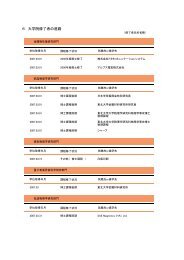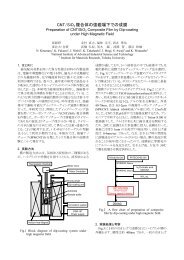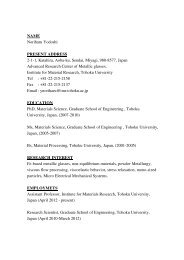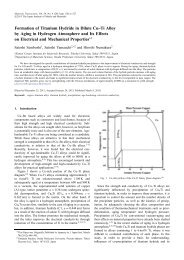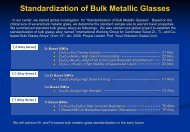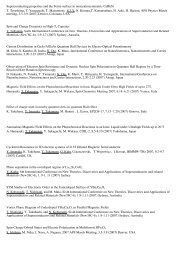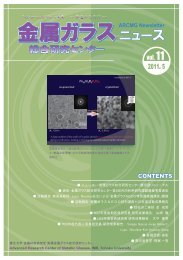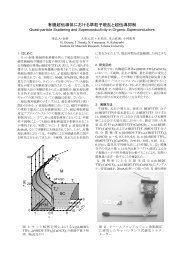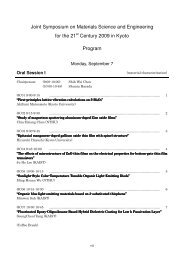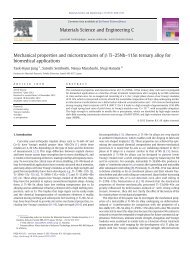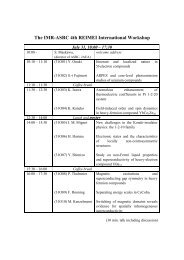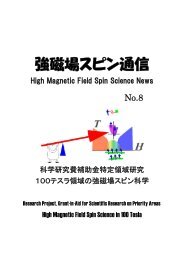ARCMG Newsletter - éå±ã¬ã©ã¹ - æ±å大å¦
ARCMG Newsletter - éå±ã¬ã©ã¹ - æ±å大å¦
ARCMG Newsletter - éå±ã¬ã©ã¹ - æ±å大å¦
Create successful ePaper yourself
Turn your PDF publications into a flip-book with our unique Google optimized e-Paper software.
金 属 ガラス 総 合 研 究 センターニュース Vol. 14<br />
Fig.1.<br />
XRD patterns of BCP powders; (a)<br />
as-synthesize<br />
d, (b) as-calcined.<br />
FTIR<br />
spectra for the as-synthesized<br />
powderss<br />
presented in Fig. 2(a) have<br />
indicated the vibrational<br />
modes of PO4 groups at 574, 603, and 1020-1120 cm - 1<br />
and OH groups (630 and 3570 cm -1 ) of apatite phasee<br />
for the powders. FTIR patterns also tend to coincidee<br />
with the results from XRD by the way that thee<br />
as-synthesize<br />
d powders were characteristic<br />
of<br />
crystalline HAp phase. The presencee of adsorbedd<br />
water could be detected from FTIR spectra in thee<br />
region around 3300-3600 cm -1 . Otherr informationn<br />
from FTIR spectra of as-synthesized<br />
powders iss<br />
presence of carbonates groups at 870 cm<br />
-1 , which aree<br />
due to the adsorption of species remaining from thee<br />
aqueous precipitation. The presence of o nitrates inn<br />
the as-synthesized powders is clearly witnessed inn<br />
the FTIR patterns in the region around at 825 andd<br />
1385 cm -1 . From the FTIR<br />
spectra presented in Fig.<br />
2(b), the overall spectra are appeared at havingg<br />
mainly two modes corresponding to characteristicc<br />
c<br />
PO4P<br />
3- and OH<br />
- groups.<br />
Fig.2. FT-IR spectra of BCP powders; (a) as-synthesized, (b)<br />
as-calcined.<br />
To determine the changes in the degradationn behavior of thee<br />
prepared BCP powders as a function of soaking time inn<br />
HBSS. Fig. 3 shows the typical features off powders after<br />
immersing in HBSS for 1, 2, and 3 weeks, respectively.<br />
After<br />
immersion in HBSS for 1 week, thee<br />
precipitation<br />
starts to be<br />
formed with individual<br />
small pieces on each BCP powders. With increase of<br />
soaking time, the pieces gradually grow<br />
together to<br />
form a densee layer on the overall BCP powderss<br />
surface. The EDS analysis showed thee new formedd<br />
precipitates had<br />
the Ca and P, indicating calcium deficient<br />
apatite phase.<br />
Fig.3. SEM morphologies of calcined BCP powders after<br />
immersion in HBSS for (a) 1, (b) 2, and (c) 3 weeks, (d) EDS<br />
f (c).<br />
Fig.4. Changes of o Ca 2+ and PO44 3- ions concentrations in<br />
HBSS immersedd with calcined BCP powder with 3 weeks.<br />
The ICP-AESS analysis reveals the changes of Ca 2+<br />
and PO4 3- concentrations inn HBSS after immersing<br />
the BCP powder, as shown in Fig. 4. The<br />
concentration<br />
of Ca 2+ and PO4 3- ions and in HBSS<br />
continually<br />
decreased d<br />
with<br />
immersing<br />
time,<br />
suggesting that the Ca 2+ and PO4 3- ions might be<br />
consumed by formation f of a new product. the Ca 2+<br />
and PO4 3- ions in HBSS were continuously consumed,<br />
which indicated that the Ca 2+ and PO44 3- ions were<br />
supersaturatedd around thee magnesiumm substituted<br />
BCP powder and a a new calcium deficient apatite<br />
phase continually grew on the sample surfaces with<br />
increase of immersing time.<br />
This study demonstrates that the co-precipitation<br />
method is an effective e technique for preparing BCPs<br />
whose content in β-TCP and HAp can be precisely<br />
determined from the precursor solutions. After<br />
immersion in HBSS H for 1 week, precipitation started<br />
at<br />
individual small particles on the BCP powders.<br />
With increases in the soaking time, the t particles<br />
gradually greww together andd formed a dense layer on<br />
the specimen surface. s Furthermore, BCP have been<br />
shown to be effective for<br />
new bonee generation<br />
implant materials.<br />
During the two months of f collaboration with Prof.<br />
H.Kato and staff s members, we have done some<br />
valuable explorations to synthesize some novel<br />
biomaterials by b using the e advanced apparatus in<br />
IMR and WPI. These materials have a great<br />
potential for medical m applications.<br />
I would like too express my sincere gratitude to Prof.<br />
H.Kato for the t invitation to IMR of Tohoku



